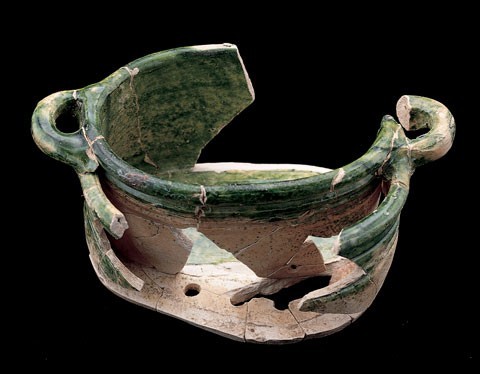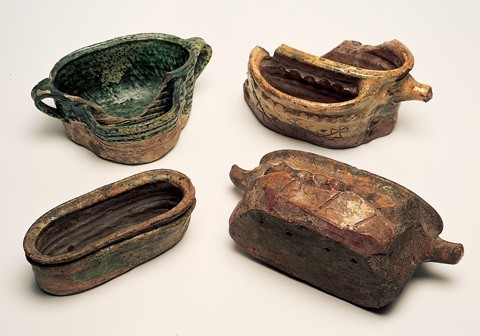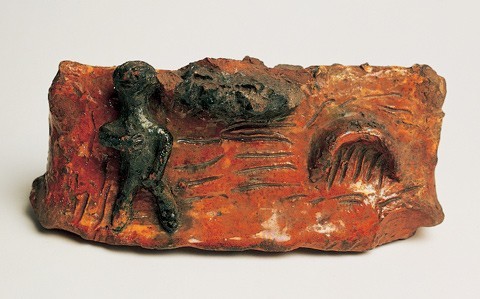
Double-wall vessel, Hampshire Surrey Border ware, ca. 1610. Lead-glazed earthenware. L. 9.1". (Object # 850-jr. Association for the Preservation of Virginia Antiquities, Jamestown Rediscovery collection; photo, Gavin Ashworth.)

Group shot of double-wall vessels in the collections of the Museum of London. Counterclockwise from the bottom left: 79.120/7, London redware, H. 3.9", W. 6.9"; a5352, London redware (shot on side), H. 3.7", W. 6.3"; a5143, London redware (single lobe), H. 2.6", W 6"; a27902, Hampshire Surrey Border ware (BORDG), H. 3.1", W. 5.3". (Courtesy, Museum of London.)

Lid, with view of nude male, London redware, sixteenth/seventeenth century. Lead-glazed earthenware. H. about 3". (a10669. Courtesy, Museum of London.)
Through the centuries, clay vessels have been produced in a wide range of shapes and sizes as dictated by the needs of society. While ceramics have been primarily used for processes involved with the preparation, consumption, and storage of food, they have also served to supplement many other aspects of human existence from lighting the dark night to disposal of bodily waste.
The function of most ceramic forms from America’s colonial past is readily known through the similarity of forms used in modern times. Early cookbooks, inventories, advertisements, and paintings have also shed light on the functions of different ceramic vessels. But, occasionally, a rare form will surface whose purpose remains elusive. Such is the case with a double dish that was excavated in 1997 from the site of James Fort in Jamestown, Virginia (fig. 1).[1]
The dish was found in a refuse pit with a fill date of circa 1610. It consists of two deep straight-sided compartments.[2] The larger compartment is ovoid in shape and has a horizontal loop handle attached to each of its narrow ends. A slightly shallower, and much narrower, compartment is attached to the front of the vessel. Its base is pierced with a line of four holes, each almost one-quarter of an inch in diameter. This piercing, along with the lower profile of the secondary dish, suggests that perhaps some substance was to spill out of the larger bowl and drain through the smaller. The vessel is glazed only on the interior of the large compartment and over the exterior rim cordoning of both sections.
Although unique in America, the double dish form is known in England where at least twenty-two vessels have been excavated from late-sixteenth- and early-seventeenth-century contexts (fig. 2).[3] There, “they have been variously described as flower vases, and as ecclesiastical Holy Water containers.”[4] More recent speculation has considered candle or soap making. None of these explanations are entirely satisfying, as evidenced by the recently released glossary of ceramic forms by the Medieval Pottery Research Group. It documents the form as “a rare ceramic form, presumably with a specific function which remains unknown.”[5]
None of the vessels show signs of sooting or burning, so the form does not appear to have been used in the warming or cooking of food. All double dishes have a perforated front, or smaller compartment, with anywhere from two to four round holes in the base. Finally, all the known examples are one of two wares: green-glazed Border ware,[6] as is the Jamestown vessel, and a yellow-slipped London redware designated Post-Medieval Slipped Redware Yellow (PMSRY).[7] These were the two mainstream pottery industries that supplied much of London’s pottery during the sixteenth and early seventeenth centuries.
Although the main form produced by the two industries remains unaltered, there are some interesting differences between the two products.[8] Unlike the Border ware examples, the redware vessels are crudely made and thickly potted with heavy knife trimming around the base and lower sides. Some have sgraffito decoration in simple geometric patterns arranged along straight and zigzag lines; others display floral or foliate patterns. All double dishes have two handles, although the form varies from vertical and horizontal loops in Border ware to chunky, solid lugs in PMSRY. Finally, there is a PMSRY lid in the Museum of London collection that appears to fit the ovoid shape of the larger compartment (fig. 3). The lid consists of a steeply pitched roof with a gable on each side. Strangely, a naked male figure stands by one gable and a naked female at the other. Is this a clue as to the vessel’s possible use? Could it be a ceremonial vessel, perhaps commemorating a betrothal?
The limited late-sixteenth-century through early-seventeenth-century context for the double dish form, as well as its confinement to solely English contexts, suggest that the form is responding to some new cultural development at the end of the Tudor period. It is surprising that no other ceramic industry in the London area made the double dish. One might expect to see it in delft or in fine redwares from Essex, but perhaps this likelihood has chronological implications. The double dish form may simply have gone out of vogue by the time these two industries had begun to flourish during the first half of the seventeenth century.
Jacqueline Pearce
Senior Archaeologist
Specialist Services
The Museum of London
<http://www.molas.org.uk/pmpot.html>
Beverly Straube
Curator, Jamestown Rediscovery
Association for the Preservation of Virginia Antiquities
<http://www.apva.org/staff.html>
Object # 850-JR. In the collection of the Jamestown Rediscovery of the Association for the Preservation of Virginia Antiquities.
The vessel measures 9.1 in. long and 5.1 in. wide overall. The height of the large compartment is 3 in. and the smaller is 2.7 in.
Fifteen double dishes have been recognized in the Museum of London collection. At least three of these vessels have been found in Basing House, Hampshire, England (Stephen Moorhouse, “Finds from Basing House, Hampshire,” Post-Medieval Archaeology 4 [1970]: 50); three are in the British Museum and one is in the Ashmolean Museum, Oxford (Moorhouse, “Finds,” p. 51).
Moorhouse, “Finds,” p. 51.
Medieval Pottery Research Group, “A Guide to the Classification of Medieval Ceramic Forms,” Occasional Paper No. 1 (London: British Library Cataloging Publication, 1998).
Border ware derives its name from its area of production—a number of potting centers situated along the borders of Surrey and Hampshire counties in England. This area was a major supplier of London’s domestic earthenware from the late sixteenth century through the late seventeenth century.
Post-Medieval Slipped Redware Yellow (PMSRY) is a term applied to white-slipped redwares, with a clear lead glaze appearing yellow, that were produced in London-area kilns during the sixteenth and early seventeenth centuries. This ware was usually reserved for the more decorative redware forms, whereas the unslipped redwares of the region were produced for the utilitarian kitchen and storage functions.
Both types appear to have been made by throwing an open-based cylinder then deliberately deforming it into a roughly subrectangular vessel. The second, smaller compartment would have been made in the same way from a smaller cylinder, then cut across the diameter and luted onto one side of the main dish. A slab of rolled-out clay was cut to the shape of the double-compartmented form, secured to the base, and trimmed to remove excess clay.
